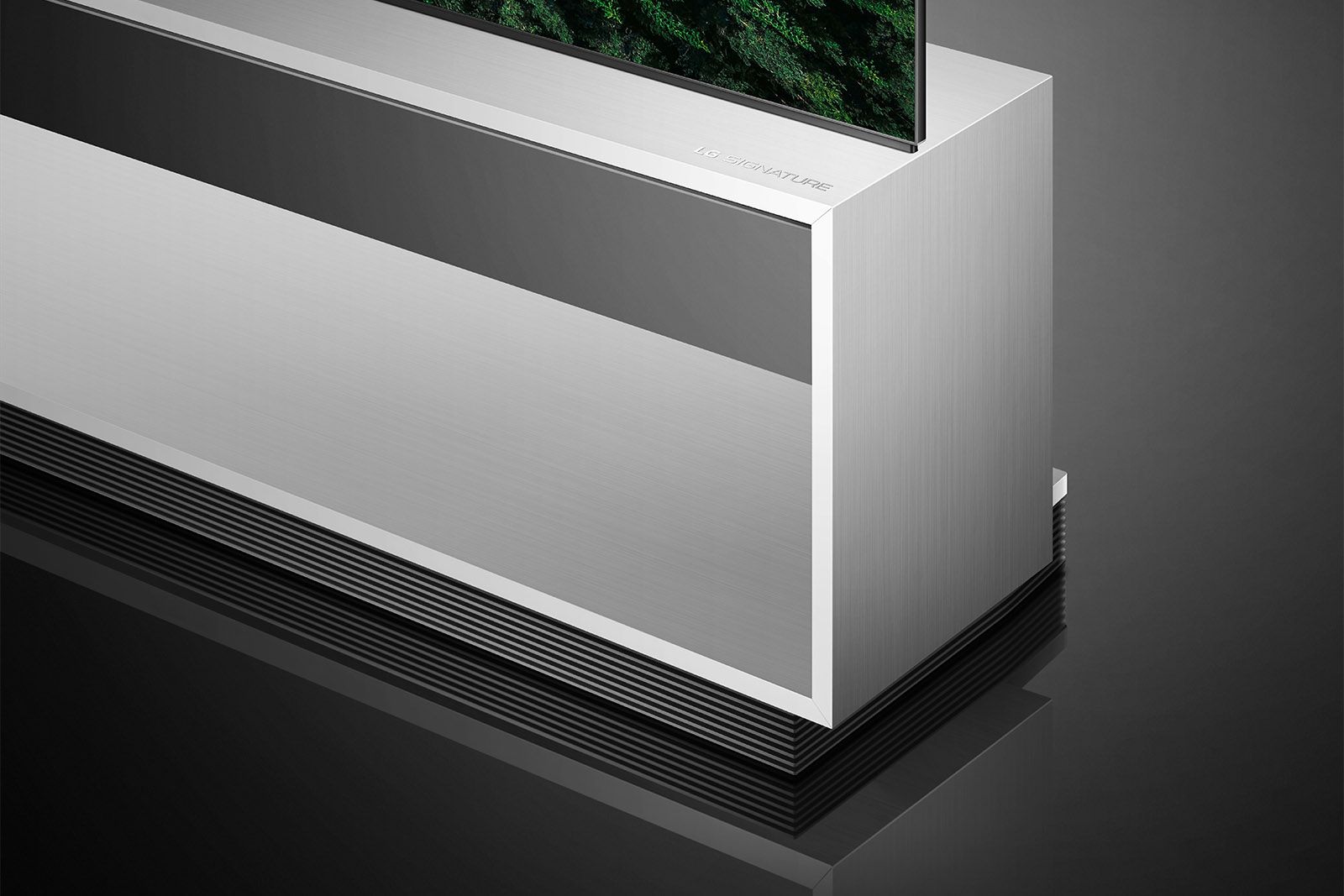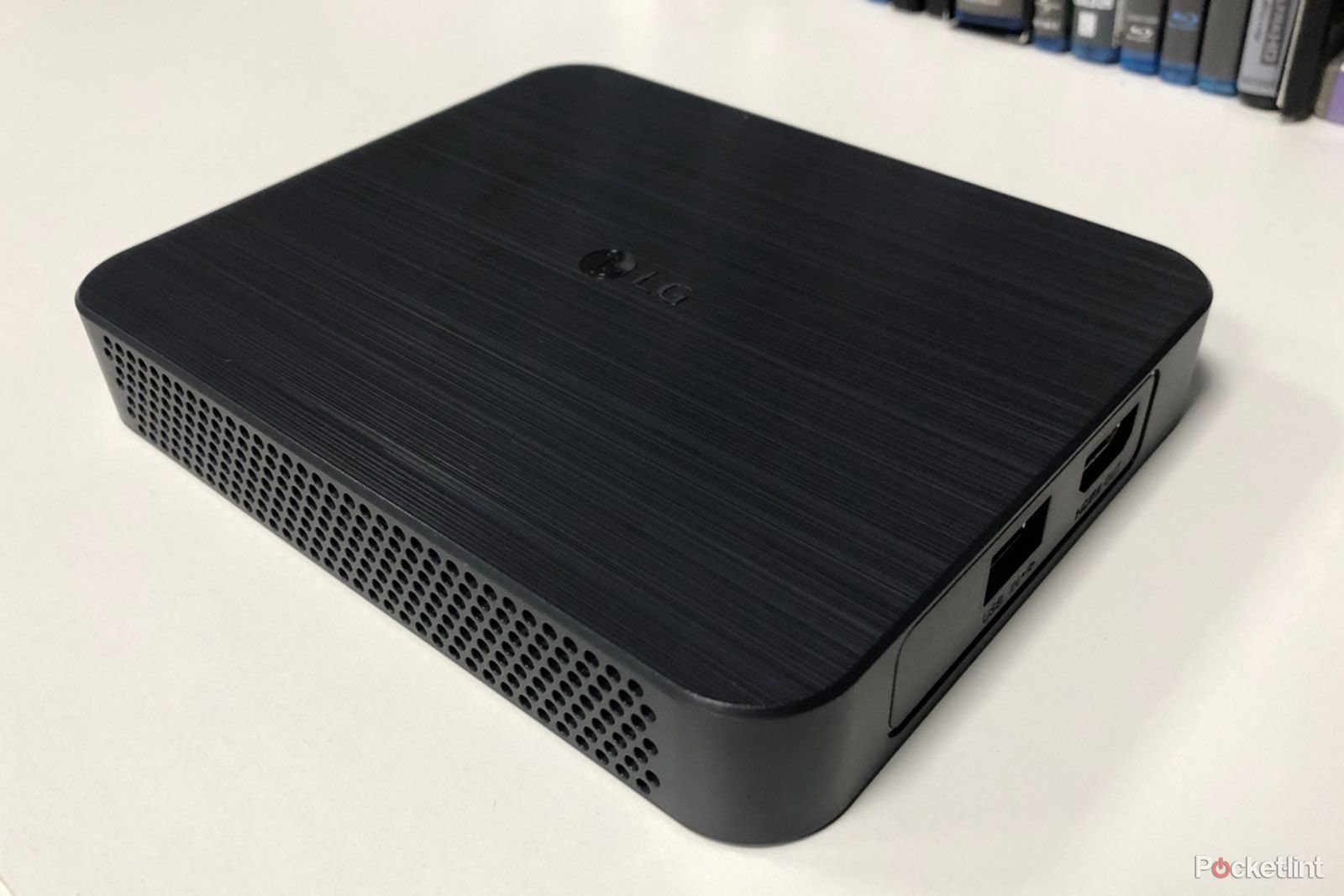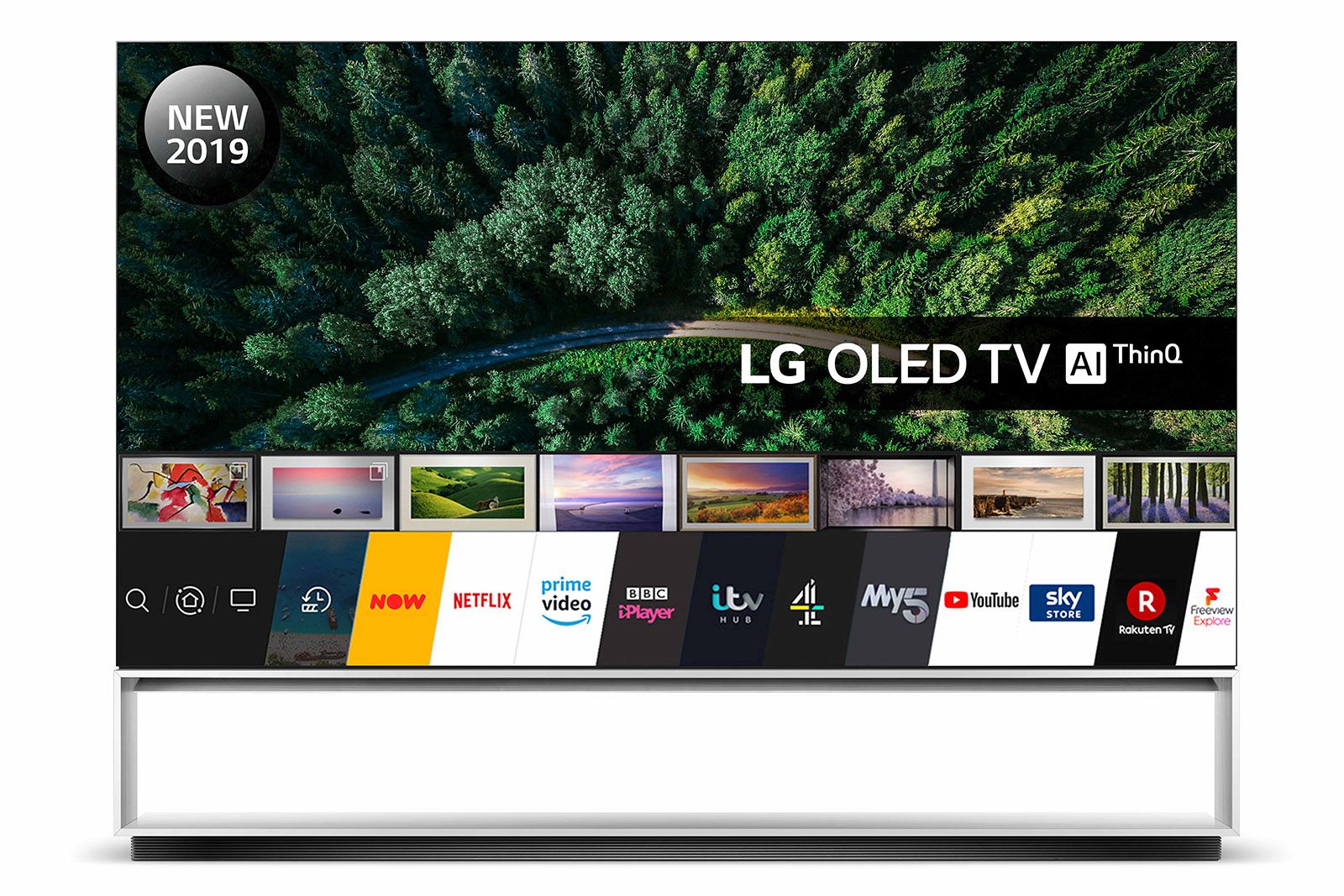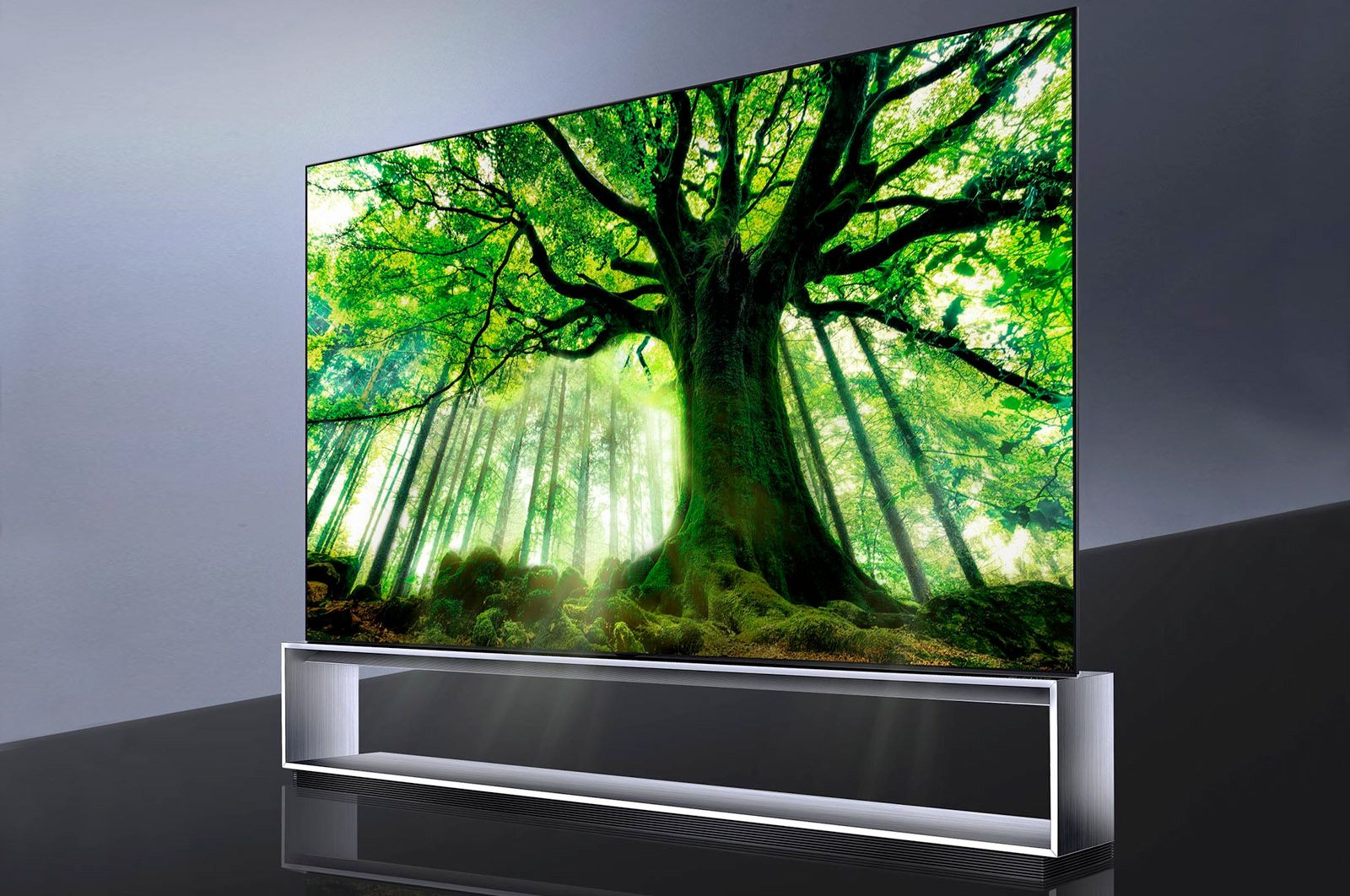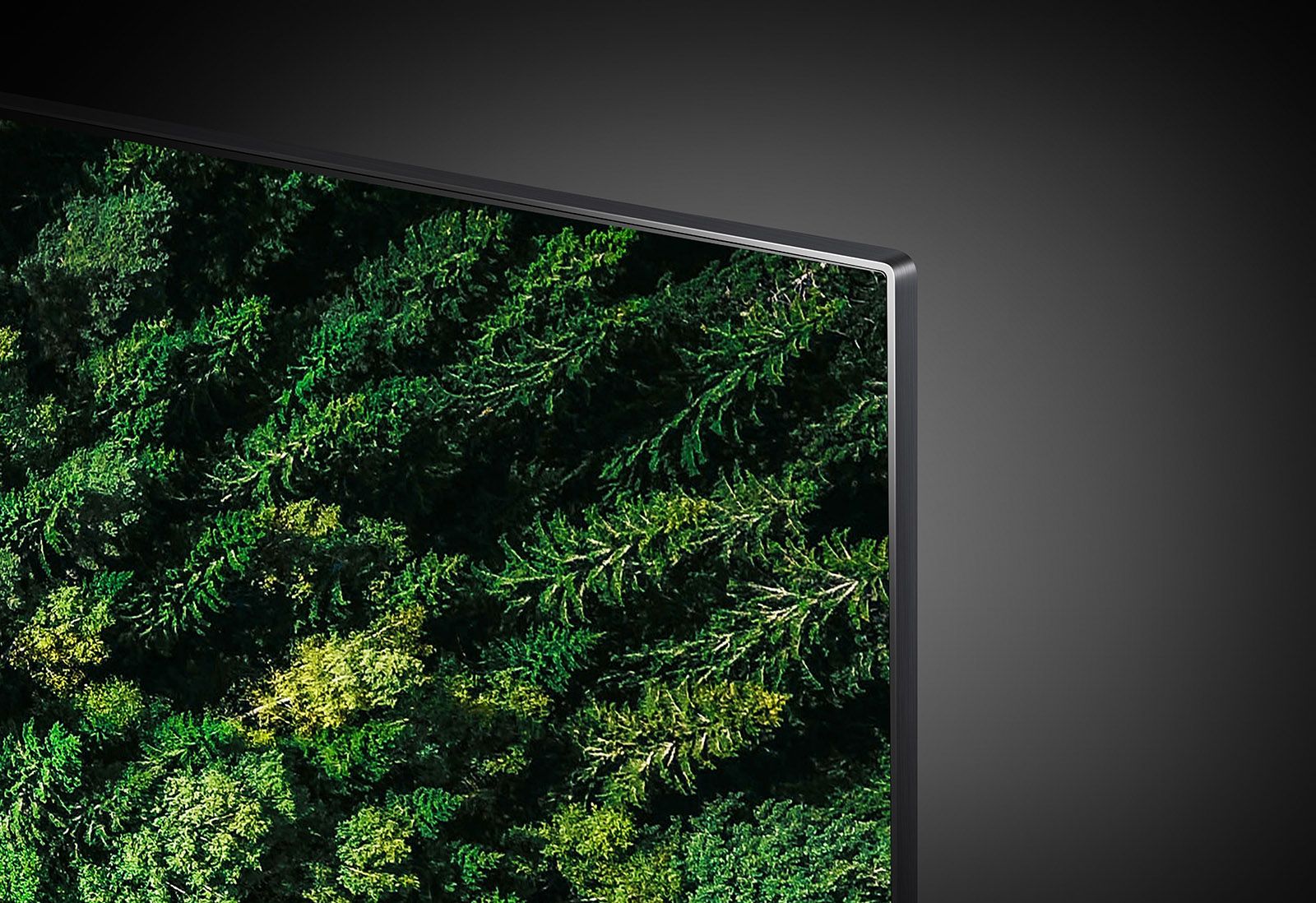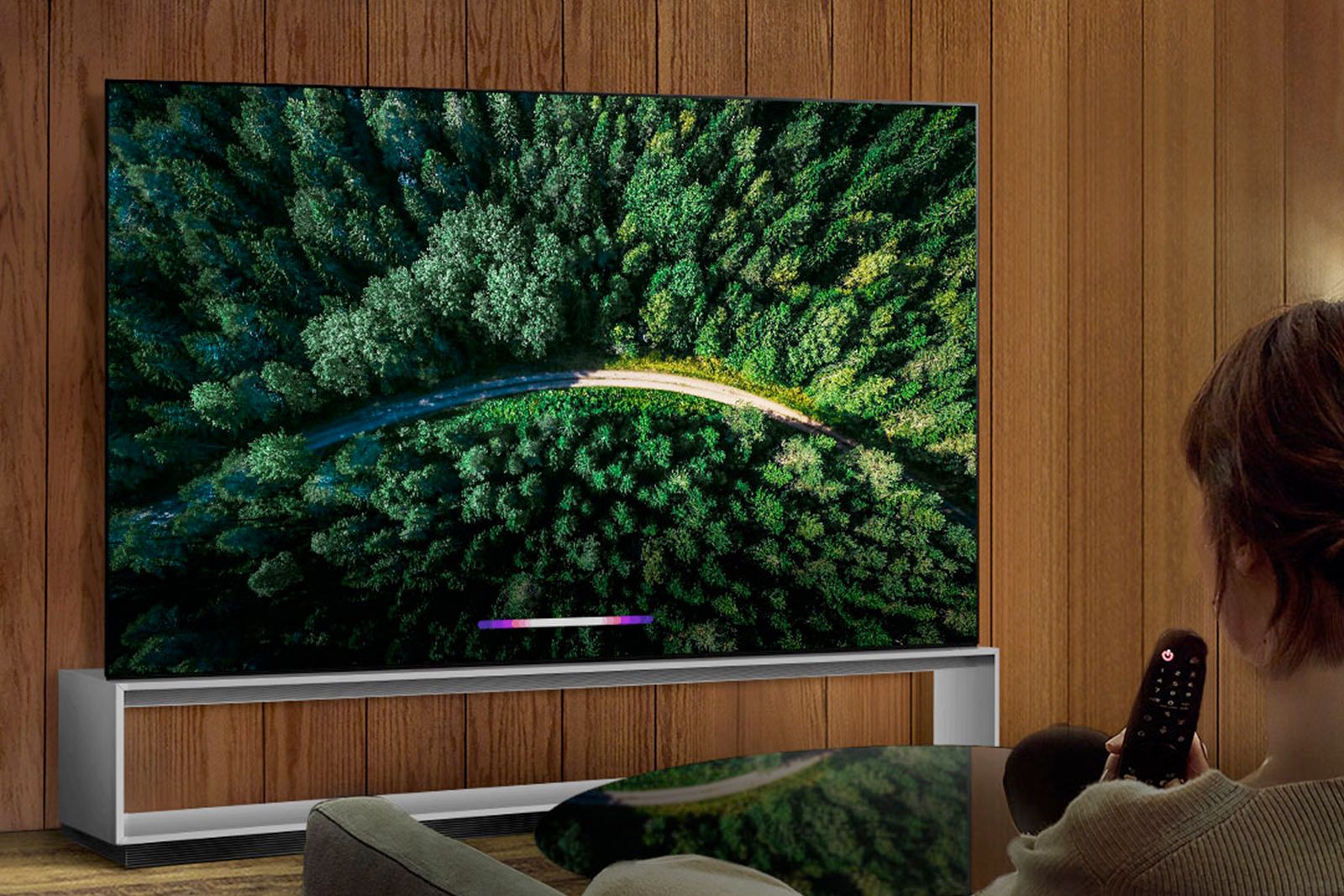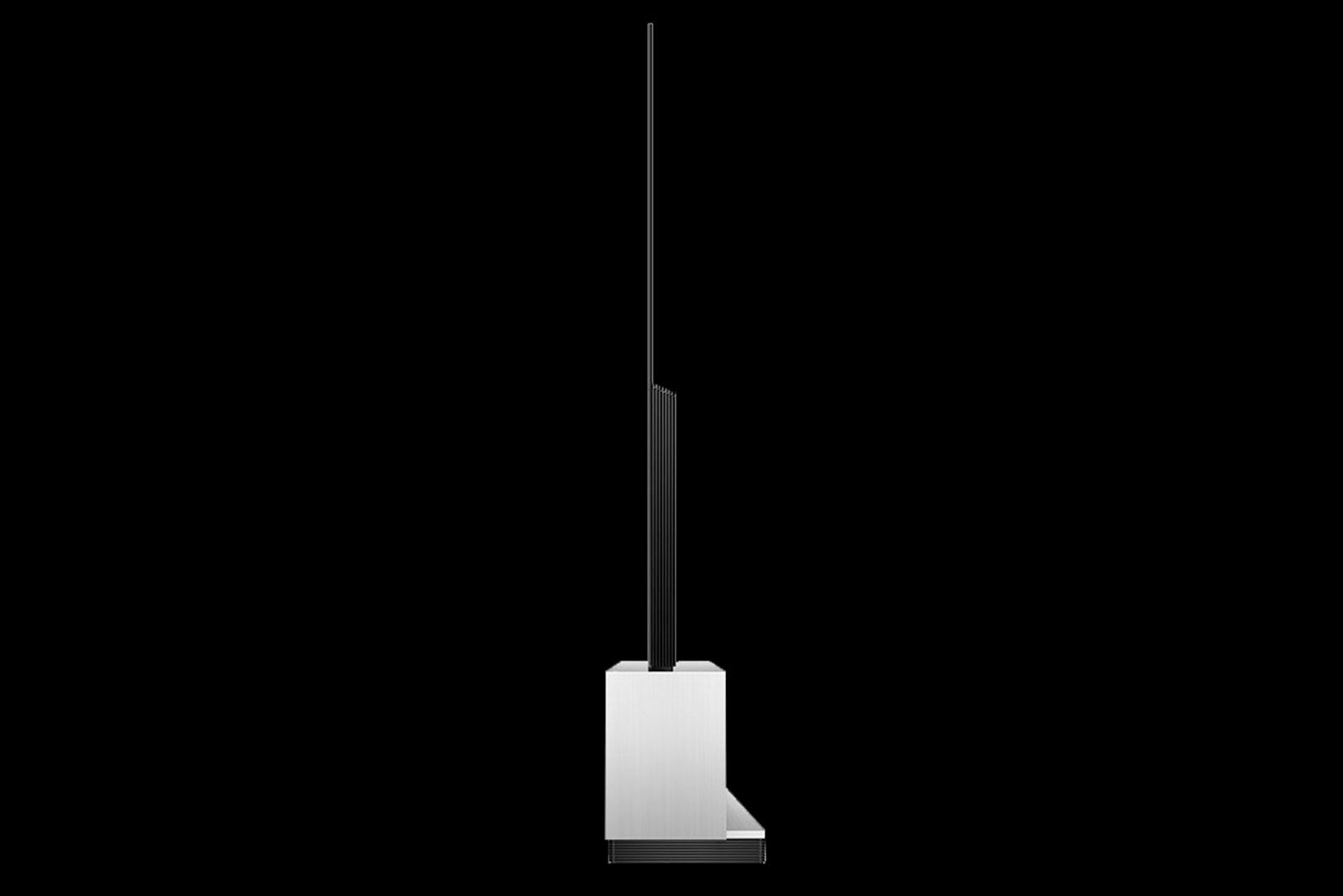LG finally joins the 8K fray with a new OLED TV that not only supports the higher-resolution format but boasts the largest screen size the company has ever produced, at 88-inches. It also includes all the features currently found on the rest of LG's 2019 line-up, making it one of the best-specified and smartest TVs on the market.
So what does the Z9 add apart from a massive screen and eye-watering £30,000 price tag to boot? There's the 8K panel of course, along with an updated version of LG's second-generation Alpha 9 processing chip optimised for the higher resolution. There's also an upgrader box to keep the decoding current, and beefed-up sound built into the attractive stand.
Our quick take
Let's be honest, the majority of people won't be able to afford the Z9. Not even close. Thirty grand is a staggering amount of money for a TV, especially when you consider there's no native 8K content yet. However, as a technological statement the Z9 is a remarkable achievement.
The Z9's upscaled 4K HDR images look sublime, while overall performance is accurate, refined and accomplished. You simply won't see better pictures, with as precise details, gorgeously nuanced colours, deep blacks and well-defined highlights elsewhere on an OLED panel.
It's also superbly specified, with an incredibly smart and intuitive operating system and just about every feature imaginable. In fact only the lack of HDR10+ support stops the Z9 being almost perfect in that respect. If you have the means you won't be disappointed, but there are cheaper options for we normal folk - but if this 8K set has you enticed then go look at the LG C9.
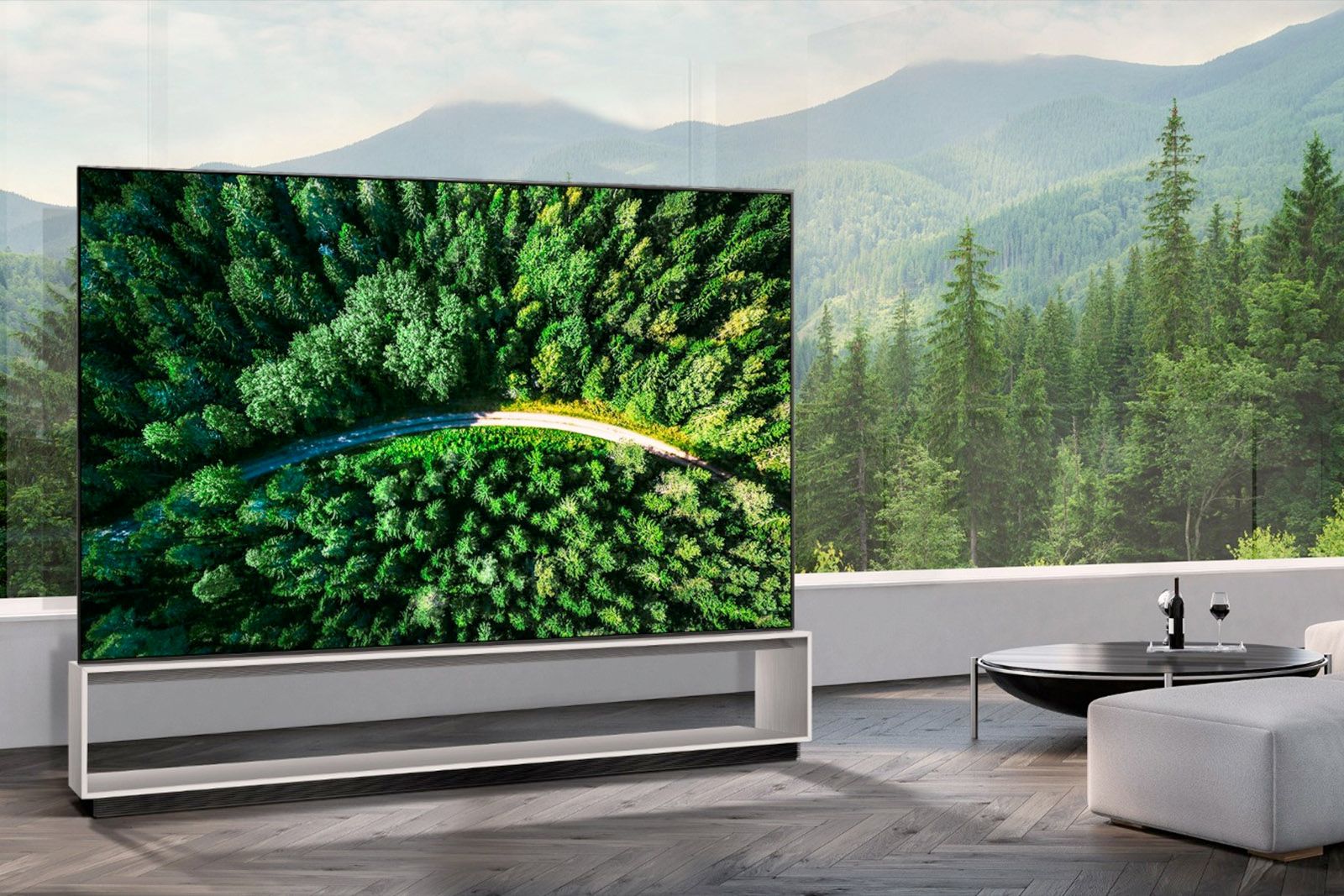
LG Z9 8K OLED TV - 5.0 / 5
| FOR | AGAINST |
|---|---|
|
|
LG OLED88Z9PUA
Artistic Sculpture Design
- 4x HDMI 2.1, 3x USB
- LAN, Wi-Fi and AirPlay 2
- 1,961 x 1,456 x 281mm; 102kg
The LG Z9 is a gorgeous piece of industrial design that manages to appear unobtrusive despite sporting a massive 88-inch screen. The panel benefits from a bezel-less screen and measures just 10mm deep at the top, although it gets deeper at the bottom where it attaches to the stand.
The stand itself is finished in brushed silver, and provides a sense of space and airiness by having a big hole in the middle that helps the TV take pride of place in your lounge without dominating it. If you've got a big enough lounge, of course. However, it isn't just a clever piece of design, it also serves a practical purpose.
The downward-firing speakers at the bottom of the panel have their sound redirected to fire out through that hole and towards the listener (LG does something similar on the C9). In addition there are two subwoofers built into the bottom of the stand to create a 4.2-channel sound system, no extras required.
That hole also means you can also place ancillary equipment like Blu-ray players and games consoles into the space, although many will prefer to keep the appearance clean. The only downsides to the stand are that the silver top is quite reflective, and you obviously can't wall mount the Z9 - hardly a surprise considering its 102kg mass.
It's a testament to how well-specified LG's 2019 TVs are that this model has exactly the same connections. In the case of the Z9 you obviously need HDMI 2.1 to handle 8K, but it also supports features like higher frame-rates up to 120Hz, dynamic metadata for HDR, eARC (enhanced audio return channel), variable refresh rates (VRR), and auto low-latency mode (ALLM).
The compression codecs used to deliver 8K are currently in development, which means the Z9 is shipping without the benefit of a clear industry standard. To avoid its new TV suddenly finding itself redundant, the company is releasing an upgrader box at the end of the year. This will be free to existing owners - you'd hope so, given the £30k outlay! - and will be bundled with new purchases starting in 2020.
The box connects to the Z9 using an HDMI input and one of the USB ports, and can be updated as and when a new 8K compression codec becomes available. The downside to the box is that you lose an HDMI input, but on the plus side your very expensive TV will remain cutting-edge for years.
Smart features
- webOS 4.5 with ThinQ AI
- Magic Remote included
- Google Assistant
- Amazon Alexa
LG's TVs are state-of the-art when it comes to smart features, and the Z9 is no exception. It boasts the latest version of webOS, which still sets the standard for smart platforms. It's built around a launcher bar at the bottom, and a second tier that uses an AI-enhanced preview feature to make recommendations based on factors such as viewing habits or the time of day.
LG offers a comprehensive selection of apps that includes Netflix, Amazon, YouTube, Now TV, Rakuten, and all the UK TV catch-up services. Where appropriate these apps also support HDR, HLG, Dolby Vision and Atmos. Thankfully there's also a new Intelligent Edit feature that lists your apps based on how often you use them, making it easier to navigate all this choice.
About the only major app currently missing is Apple TV, but LG makes up for that with support for AirPlay 2 (including Dolby Vision and Atmos), as well as Apple HomeKit. There's also a Home Dashboard that's been expanded to show all connected mobile devices, inputs and home IoT devices, thus allowing you to monitor and control any connected device in your smart home from a single hub.
If you want a smart assistant you're spoilt for choice, with both Google Assistant and Amazon Alexa built-in (you can even access Siri via AirPlay). The Z9 also has device auto-detection via HDMI, and you use your LG smartphone to setup the TV. There are also added images in the Gallery section, a new mini-browser, and a TV channel banner with added recommendations.
Alpha 9 2nd Gen: An 8K twist
- HDR Support: HDR10, HLG, Technicolor and Dolby Vision
- Processing engine: Alpha 9 Gen 2 Intelligent Processor 8K
The LG Z9 uses an 8K (7680 x 4320) 10-bit OLED panel, which means it has over 33 million self-emissive pixels.
Since each pixel is composed of white, red, green and blue that equates to more than 130 million sub pixels. When do the maths you quickly understand why the screen is so big, and the problems LG will have making smaller sized 8K OLED panels.
To accommodate the increased resolution, the Z9 uses an updated version LG's second-generation Alpha 9 processor. This state-of-the-art chip uses deep learning algorithms to analyse content and establish the genre and quality, before optimising that image using upscaling, noise reduction and other enhancement tools.
This updated version adds six-step noise reduction instead of the current four-step, along with frequency based sharpness enhancements, object depth enhancements, and advanced colour enhancements. All these features are combined to allow the Z9 to deliver the best possible picture regardless of the quality of the source.
As with LG's other 2019 TVs the Z9 includes the AI Brightness feature in the Cinema Home mode, which uses a light sensor to detect ambient light, and then optimise the brightness based on the viewing environment to improve the visibility in darker areas of the picture. It also includes AI Picture processing that analyses the image and upscales it accordingly. This mode is particularly effective with poor quality material like heavily compressed streams or standard definition content.
The Z9 supports both VRR and ALLM, with these features automatically enabled using the Fast Game Response setting. In testing this worked flawlessly in conjunction with an Xbox One X, automatically engaging the game mode with gaming content. The game mode offers full calibration options, and serious gamers will be delighted by the extremely low input lag of 17.9ms.
The 8K conundrum
There are two major issues with 8K, one obvious and the other perhaps less apparent.
The obvious problem is that outside of Asia there's a complete lack of native 8K content, and this situation isn't going to change any time soon. However, as we'll discuss later in this review, there are other benefits to having an 8K panel.
If you can get hold of some native 8K content the results are spectacular. LG provided a five minute demo reel put together by imaging experts Spears and Munsil, and this 8K HDR10 footage is simply jaw-dropping in its detail. Every leaf, blade of grass or hair in a close-up is perfectly defined. The blacks are unsurprisingly deep, while shadows are detailed, highlights free of clipping, and colours beautifully saturated. Overall it provides a tantalising glimpse of the future.
The other issue that has gained some coverage recently (mainly thanks to LG it has to be said) is what exactly constitutes 8K resolution? The obvious answer is to count the pixels, but it isn't quite that simple. The current approach is to use contrast modulation (CM), which not only determines the actual number of pixels but also establishes how well they can be distinguished.
LG is keen to demonstrate that its 8K TVs perform better using this test, and when viewed up close each pixel is clearly visible. This is not the case with some competing 8K TVs, where the pixels appear blurry when viewed under a microscope. The reason for this is that unlike OLED and IPS LCD panels, VA LCD panels have narrow viewing angles and the technology employed to improve this limitation affects pixel definition.
Does this really matter? In an absolute sense it might mean that very fine detail won't be as precisely rendered on a VA LCD panel as it is on a TV using OLED or IPS LCD. However, you don't watch TV sat centimetres from the screen or through a microscope, so what's important is the perceived image as seen from a normal viewing distance.
Spectacular HDR images
In light of the fact that native 8K content will remain thin on the ground for the foreseeable future, the most important aspect of the Z9's performance is how it handles lower-resolution content. Here the 88-inch OLED delivers some of the best images you'll ever see, especially when it comes to 4K and HDR.
For the purposes of subjective testing we ran through a host of 4K Blu-rays that included Guardians of the Galaxy Vol.2, IT, 2001: A Space Odyssey, and La La Land. This provided an opportunity to see how the Z9 handled both HDR10 and Dolby Vision content in terms of perceived resolution, colour reproduction, and tone mapping.
It's fair to say the Z9 aced the boards as far as these subjective tests were concerned, delivering fantastically detailed and precise imaging. The upscaling makes full use of all those millions of additional pixels in the 8K panel, and the tone mapping ensures that shadows retain detail and peak whites are free of any clipping.
The space scenes in 2001 are beautifully rendered with the white spaceships perfectly juxtaposed against the black void. The 4K disc uses an 8K scan of the original 65mm camera negative, and the level of detail is astonishing. From the intricate design of the spaceships to the remarkable make-up in the 'Dawn of Man' sequence, the image is frequently awe-inspiring.
The Z9 handles the wider colour gamut of HDR equally as well, reproducing all the subtle shades with a nuanced accuracy. The psychedelic fever dream of Guardians is rendered in candy-coloured hues, while the deliberately saturated primaries in La La Land effectively recreate the look of Technicolor musicals from the fifties.
The dynamic tone mapping feature makes for a useful additional tool. It analyses HDR10 content on a scene-by-scene basis and adjusts the tone mapping accordingly. As a result the shadows are better defined and highlights are brighter. It certainly works well with both Guardians and La La Land, with the stage sequences in the latter benefiting from a pixel precision in the spotlights.
IT includes Dolby Vision, and the scene with the kids in the sewers is a great example of the format's potential. The tunnels are pitch black in certain areas, but the shadow details are perfectly defined in others. When one teenager lights up an aerosol canister, the burst of flame is a bright blast of colour that illuminates the entire tunnel.
The Z9 processes Blu-ray discs with a similar level of skill, the upscaled images looking almost as good as 4K content, even if 1080p lacks the punch of HDR. The opening black-and-white sequence in Casino Royale is delivered with clear whites and finely defined greys, while the Madagascar sequence is filled with detail and colour. The opening is deliberately grainy, which the Z9 retains, but later scenes are clean and expertly defined.
Watching highly compressed or very low-resolution content reveals how good the AI processing can be, cleaning up the images and delivering them as well as possible. The motion handling is also very good, with 24p content free of unwanted judder and the motion in Gravity rendered with a fluidity that remains film-like.
Speaking of motion, the Z9 is an equally accomplished performer with higher frame-rate games. A non-HDR title like Forza 6 delivers detail and smooth motion that draws you into the high-speed racing, while the HDR-enhanced Star Wars: Battlefront II gives Luke's lightsaber a suitably impressive glow. The in-play responsive is slick and fast, which is sure to please well-do-to gamers.
Any issues?
The LG Z9 performs exceptionally well in testing, both in terms of subjective viewing and objective measurements. The peak brightness is nearly 800 nits, which is good for an OLED but a far cry from the 4,000nits that Samsung's 8K QLED TVs can deliver, like the Q900. However, the pixel-level precision and blacks of OLED means HDR retains plenty of impact despite the lower numbers
LG TVs support almost every form of HDR imaginable, not only Dolby Vision but also HDR10, broadcast HLG, and even the largely unadopted Technicolor. However LG doesn't include HDR10+, which is annoying because this alternative version of HDR with dynamic metadata is starting to gain traction, and for £30K you'd expect your new TV do do everything.
Big and boisterous sound
- 4.2ch; 80W
- AI Sound
- One Touch Sound Tuning
- Dolby Atmos
Size and resolution aside, the other big difference between the Z9 and other models in LG's TV line-up is its audio capabilities. The increased screen size and bigger stand provides an opportunity for LG to install four larger speakers for the main channels, and a brace off subs for the low-end. There's also a decent 80W of power to ensure the sound doesn't run out of steam.
The Z9 also includes all the usual sonic features found in LG TVs such as One Touch Sound Tuning and AI Sound. The latter applies psychoacoustic trickery to take two-channel audio and turn it into virtual 5.1 surround sound, thus creating the illusion of a more immersive surround presence. There's also support for Dolby Atmos object based audio.
The audio delivery is certainly able to keep pace with the visuals, and the Z9 produces a big and boisterous soundstage with excellent stereo imaging, precise placement of effects, surprisingly deep bass and clear dialogue that's focused on the screen. The song and dances numbers in La La Land are delivered with gusto, and you can crank the Z9 up without the sound distorting.
LG OLED88Z9PUA
To recap
This stunning 8K OLED TV boasts the largest screen size to date and some of the best HDR images you’ll ever see. The benefits of 8K remain subtle, but the inclusion of cutting-edge processing and state-of-the-art smart features makes this a comprehensive and beautifully designed package. The only downside is you’ll need to remortgage the house to buy one.

